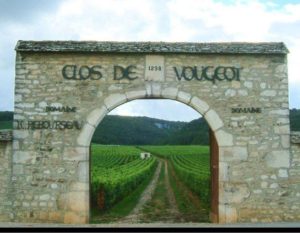 1977: FIRST NEXUS COMMISSION Bob Becker tells us that “The first piece commissioned by NEXUS came from the Canadian composer Bruce Mather in 1977. (We would premiere it in April ’78.) At that time, Bruce’s music was known only vaguely by most of us, but Robin Engelman had become an admirer. He made the commission application, and he decided it should be a quartet so that the four members of NEXUS living in Toronto (Bill has continued to reside in Rochester, NY throughout the group’s history) could rehearse without travel and scheduling concerns. Michael Craden, also a member of NEXUS at that time, was a staunch non-reader of musical notation, so he was also excluded. It was the first piece we rehearsed in a concentrated, traditional way. Bruce’s piece, Clos de Vougeot, was the first in a slow but continuous commissioning of new works by the group. In all, we have three major compositions by Mather, one of them a concerto. He became an intimate and very influential mentor to Robin over the years.”
1977: FIRST NEXUS COMMISSION Bob Becker tells us that “The first piece commissioned by NEXUS came from the Canadian composer Bruce Mather in 1977. (We would premiere it in April ’78.) At that time, Bruce’s music was known only vaguely by most of us, but Robin Engelman had become an admirer. He made the commission application, and he decided it should be a quartet so that the four members of NEXUS living in Toronto (Bill has continued to reside in Rochester, NY throughout the group’s history) could rehearse without travel and scheduling concerns. Michael Craden, also a member of NEXUS at that time, was a staunch non-reader of musical notation, so he was also excluded. It was the first piece we rehearsed in a concentrated, traditional way. Bruce’s piece, Clos de Vougeot, was the first in a slow but continuous commissioning of new works by the group. In all, we have three major compositions by Mather, one of them a concerto. He became an intimate and very influential mentor to Robin over the years.”
Our new piece, Clos de Vougeot, was named for an exceptional wine. In a 2012 blog post called Wine Diary October 1979, Robin wrote, “Bruce Mather, distinguished Canadian composer, oenophile and member of the Burgundian wine fraternity, le Confrérie des Chevaliers du Tastevin – Brotherhood of Knights of Wine-Tasting Cups , is a good friend and has composed many works for Nexus and members of NEXUS, all named after great French or Italian wines. le Confrérie des Chevaliers du Tastevin is headquartered in the twelfth-century Château du Clos de Vougeot in the Côte d’Or region of France. Bruce maintains wine cellars in Montreal and in Saint Lin Réffanes, France.” You can read more about the Chateau at https://www.closdevougeot.fr/en/ Mather in his long career has been a teacher, a remarkable pianist and one of the most notable composers of microtonal music. He is particularly known for his contributions to contemporary classical music and over his long career has shown a preference for works requiring small ensembles – like NEXUS!
1977: BILL AND GEORGE BillCahn says, “Around this time, I obtained a copy of the LP record, THE XYLOPHONE GENIUS OF GEORGE HAMILTON GREEN (Conservatory Album No. 7101M) containing re-pressings of some of Green’s earlier ’78 RPM recordings. Everyone in NEXUS was awed by Green’s musicianship and technical mastery. It is my understanding that Lewis Green, the stepbrother of G.H.Green, was the moving force behind this LP, and though it had success among ragtime aficionados, in terms of impact on the percussion world, it was the NEXUS performances and the release of the NEXUS Ragtime Direct-to-Disc LP in 1976 that really sparked the current worldwide interest in Green’s music among percussionists. NEXUS continued with our never-ending search for non-western instruments in antique shops. In 1977 while rummaging through a Rochester shop, I found a well-worn ’78 RPM recording of G.H.Green. This discovery inspired a 10-year research project to find out more about these old xylophone recordings and to collect information. The earliest records by George Green were made for the Edison company and contained transcriptions of classical overtures. Green’s own compositions came later. The recordings of the Green brothers were enormously popular – so popular that I can still walk into virtually any antique shop in North America and find their records. My own ’78 RPM xylophone record collection numbers in the thousands of titles by Green and many others from around the world. Concurrently with this research, I decided to arrange some of G.H. Green’s unpublished music that I had found in his recordings, so that NEXUS could play them. These arrangements were eventually published and are still available.”
Read more in Bill’s blog posts: https://www.nexuspercussion.com/2009/02/george-hamilton-green-question-feb-10-2009/ and https://www.nexuspercussion.com/2009/02/marimbaphone-vibraphone-questions-feb-20-2009/
1977: HISTORIC VENUES, PASIC, LINCOLN CENTER! In Toronto’s Massey Hall (1894) with its wonderful acoustics, we reconnected with saxophonist Bernie Piltch and cellist David Darling, as well as flautist Kathryn Moses for an improvisation. We performed rags at the Scarborough Civic Centre, only 4 years old at the time with unique architecture by Raymond Moriyama. Out on the Toronto Islands, we performed at the Algonquin Island Clubhouse (1950). (The building tragically burned down in 1989, but a huge co-operative effort quickly had it rebuilt.) Paul Horn took us to an unusual performance space,
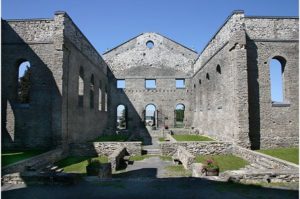
St Raphael’s Ruins
St. Raphael’s Ruins in eastern Ontario. A few years before, a fire had destroyed this church, one of the earliest Roman Catholic churches in English-speaking Canada, dating from the early 1800s. Fortunately the outer walls were spared and it was a most evocative place to play. (In 1999, it was named a National Historic Site.) We reconnected with the amazing Abraham Adzinyah (who had inspired our African repertoire) for two Toronto performances, one of them at the short-lived Centre for Experimental Art and Communication (1973-1980) an avant-garde artists collective that was forced to close a few years later, having been “charged with promoting violent overthrow of authority”. The
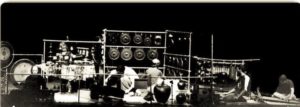
NEXUS, PASIC’77
Percussive Arts Society has kindly provided a photo of NEXUS performing at the second annual PASIC, held that year in Knoxville TN. (The first PASIC had been held in Rochester in ’76). This was our first of many PASIC performances. But our most exciting performance of the year was our
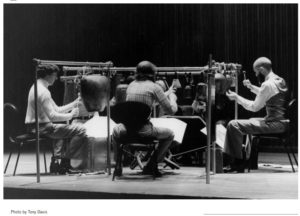
NEXUS performs Under the Umbrella, Alice Tully Hall
November appearance in New York City’s elegant Alice Tully Hall in Lincoln Centre – a mere 8 years old at the time. We performed the new work commissioned for NEXUS by Toru Takemitsu, Jo Kondo’s Under The Umbrella, its USA premiere. Keiko Abe also performed on that concert. It was presented by “Music From Japan” which had been founded a few years before in NYC. On their website they have a photo of NEXUS performing “Under The Umbrella” in that 3rd season, photo by Tony Davis.
(A side note: Russell and Bob have a misty memory of having played Under The Umbrella under a beach umbrella in Walter Hall, Toronto! It must have been the New Music Concerts performance in 1976.)
1978 ON THE ROAD AGAIN This was a crazy year. We bopped from Toronto to Rochester to Winnipeg to Vancouver to Kingston to Edmonton, spent November doing (count ‘em) twenty-two school concerts in Lennox and Addington Counties (Ontario) and then flew to England for our FIRST BRITISH TOUR: 13 performances in 14 December days, under the auspices of the British Arts Council. This came about because Steve Reich’s first British agent, Andrew Rosner, had come to know Russell and Bob during the SR&Musicians tours of the early 1970s. With all this travel, is it any wonder that we introduced Reich’s Music For Pieces of Wood into our repertoire? Five pair of claves which could all fit into a small bag. But in general, we did not travel light (see photos). Other projects: Bob, Russell and Robin were involved in R.Murray Schafer’s experimental work Loving semi-staged and recorded by New Music Concerts. The chamber orchestra was conducted by Robert Aitken with whom we’d done The Man Who Skied Down Everest. Bill had his Raga No. 1 for Solo Timpani published by Wimbledon – he’d written it 10 years before for his Eastman senior recital! – and also wrote a new piece, “Tides”, inspired by the sounds of a commercial turboprop airplane flight. We performed it in Vancouver. Bill built a wind
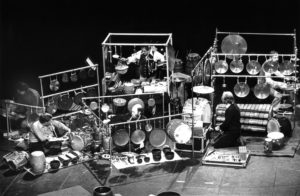
NEXUS in Vancouver
water machine for it: waterfall and wind machines combined into one rotating drum having both a wire-screen interior skin filled with marbles, and exterior wooden slats with an overlying canvas sheet. There was (and is) no such item to be found in any catalog. We had some exceptional new commissions too, but that’s for another post.
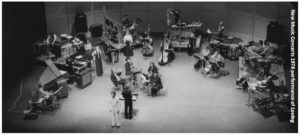
Loving, New Music Concerts
Read more: Bill’s Raga No. 1: https://www.nexuspercussion.com/2009/03/raga-no-1-for-solo-timpani-9-questions-march-17-2009/ R.Murray Schafer’s Loving: https://www.thecanadianencyclopedia.ca/en/article/loving-toi-emc Bill’s wind water machine: https://www.nexuspercussion.com/2012/05/instruments-you-cant-buy-part-2-nexus-repertoire/
1978 CLAVES and MUSIC FOR PIECES OF WOOD Bob Becker tells the claves story: “In 1973 Steve Reich wrote MFPOW. @RussellHartenberger and I were regular members of Steve’s ensemble and we were involved in the development and premiere of the piece. At first Steve was unsure about the instrumentation, and we experimented with crotales and almglocken before he settled on tuned claves. He bought four sets made by the Latin Percussion company (2 sets of “Standard” claves – solid dowels, and 2 sets of “African” claves – with a hole bored through the center of the struck clave), and one pair of traditional Mexican rosewood claves. Steve tuned the claves to specific pitches using a belt sander (the procedure is similar to tuning a marimba bar). In 1978, NEXUS added MFPOW to our repertoire and recorded it in 1982 on our album “Changes”. At that time we played a set of claves that Russell purchased and tuned, made from the same Latin Percussion and Mexican types Reich himself had used. NEXUS toured extensively in the ’80s and MFPOW became a staple, often the concert opener. We were able to perform it front and center, giving to the audience an immediate and dramatic introduction of the group and its members. Many percussion ensembles have come to appreciate this aspect of the piece, not to mention its portability and small stage footprint.
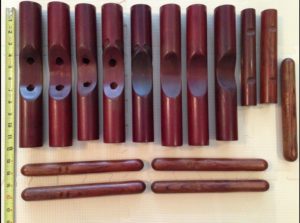 “Performing this work repeatedly in both ensembles, I found myself wishing for clearer pitches and stronger projection from the claves. It occurred to me that the relatively soft wood used by Latin Percussion could be improved on, and around 1985 I took the idea to Andrew Feldman. I first met Andrew Feldman at PASIC in 1981. For several years beginning in the late 1970s he manned a small booth at the conventions and advertised his sticks and mallets in the classifieds at the back of Percussive Notes. I bought a number of bass drum beaters and tam tam mallets from his display that year. At first I was attracted simply by the gorgeous materials and impeccable workmanship in all of his products, but I later found there were good acoustic reasons for everything Andrew did. We began a project to make Latin Percussion style claves using much denser woods. As we experimented, we found that harder woods, such as purple heart or bubinga, besides producing a significantly clearer and brighter tone, automatically produced higher pitches than Latin Percussion’s chosen woods when made in similar dimensions. We also discovered that the beater clave in these sets should be made of a slightly softer wood than the “anvil” clave. Eventually I found myself with dozens of claves made from several types of wood and placed at different transpositions of the original score. I selected the version that sounded best to my ear, which turned out to be “anvil” claves made from purple heart and beaters made from bubinga, with the “key” of the piece transposed up a whole step to D#. This became the definitive set of claves still used by NEXUS today. Soon after we began using these claves in performance Steve Reich heard us play MFPOW, and within a few months he had his own set from Andrew, which the Reich ensemble continues to use. Steve has used tuned claves effectively in more recent works as well, notably in his theatre piece The Cave. All of them were made by Andrew Feldman.” Read more in Bob’s blog post “Andrew Feldman – An Appreciation”, https://www.nexuspercussion.com/2014/08/andrew-feldman-an-appreciation/
“Performing this work repeatedly in both ensembles, I found myself wishing for clearer pitches and stronger projection from the claves. It occurred to me that the relatively soft wood used by Latin Percussion could be improved on, and around 1985 I took the idea to Andrew Feldman. I first met Andrew Feldman at PASIC in 1981. For several years beginning in the late 1970s he manned a small booth at the conventions and advertised his sticks and mallets in the classifieds at the back of Percussive Notes. I bought a number of bass drum beaters and tam tam mallets from his display that year. At first I was attracted simply by the gorgeous materials and impeccable workmanship in all of his products, but I later found there were good acoustic reasons for everything Andrew did. We began a project to make Latin Percussion style claves using much denser woods. As we experimented, we found that harder woods, such as purple heart or bubinga, besides producing a significantly clearer and brighter tone, automatically produced higher pitches than Latin Percussion’s chosen woods when made in similar dimensions. We also discovered that the beater clave in these sets should be made of a slightly softer wood than the “anvil” clave. Eventually I found myself with dozens of claves made from several types of wood and placed at different transpositions of the original score. I selected the version that sounded best to my ear, which turned out to be “anvil” claves made from purple heart and beaters made from bubinga, with the “key” of the piece transposed up a whole step to D#. This became the definitive set of claves still used by NEXUS today. Soon after we began using these claves in performance Steve Reich heard us play MFPOW, and within a few months he had his own set from Andrew, which the Reich ensemble continues to use. Steve has used tuned claves effectively in more recent works as well, notably in his theatre piece The Cave. All of them were made by Andrew Feldman.” Read more in Bob’s blog post “Andrew Feldman – An Appreciation”, https://www.nexuspercussion.com/2014/08/andrew-feldman-an-appreciation/
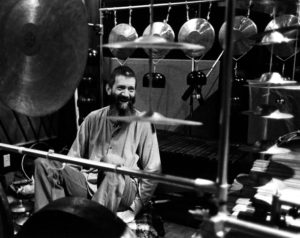
John Wyre
1978 WYRE CONNEXUS Bill says, “With a sense of adventure Andrew Davis, Music Director of the Toronto Symphony programmed Connexus by John Wyre, commissioned by the CBC. It was in fact Andrew who gave the piece its title. The work was essentially a concerto for NEXUS and much of the music made by NEXUS in the piece was to be improvised on specific instruments…We all had interesting parts to play…Robin even had a section to play on his Revolutionary War rope drum. Bob, Russ, and Michael had some good stuff in the improvs, and I had a great steel drum and harmonica part at the end.” The premiere was triumphant – we would later perform it with other orchestras as well, always to wonderful reviews. CBC producer David Jaeger remarked, “As a composer, Wyre managed to capture the magic that he felt in pure sound. Somehow his approach was simple, very clear and he just let things kind of sound forth, as it were.” Bill created a tunable bass drum for the piece that has also been used in other orchestral repertoire since.
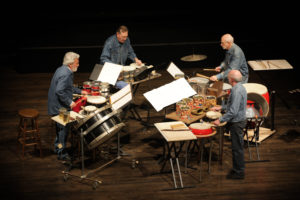
Our Third Construction setup
1978 JOHN CAGE Bob Becker says, “When I first heard Cage’s Third Construction in 1976 on a bootleg Blackearth tape recording), I was shocked. Where had something like this been hiding?” And indeed the group Blackearth is credited for “rediscovering” the piece shortly after the manuscript was made public. Blackearth had begun performing it throughout the US and Europe in January of 1977. NEXUS “had learned and practiced it somewhat haphazardly while touring,” says Bob. Bill says, “Each of the 4 parts requires drums; we decided to each have drums with a distinctive sound so listeners could hear the difference between the parts. I selected the unique sound of the flower pot drums I had created for performing Warren Benson’s Nara. These have served the Third Construction wonderfully though dozens of performances.” He continues, “This piece is one of the great masterpieces of 20C art music. NEXUS has performed at least a half-dozen performances with Cage himself in the audience. It is always totally engaging to perform it and it continues to reveal new surprises; such is the signature of a masterpiece…Unfortunately for Third Construction, it is not an opera or a work for orchestra or string quartet; it’s a work for four percussionists, and consequently it is still completely invisible to the cognoscenti in the art music world. But fortunately for percussionists, it is one among only a handful of such important works in the genre. One of the most ‘constructive’ things that percussionists can do is to expose the rest of the world to Third Construction.” We also brought Cage’s Amores into our repertoire. Robin Engelman writes of a 1977 performance he played with Bob and Russell with Cage in the audience: “The opening movement for Prepared piano is followed by 2 movements for percussion trio. Our first, the 2nd movement, was a stunner. The audience spontaneously applauded after the last note. When all had settled down, we were ready for the 3rd movement when the pianist began playing the last. Cage rose from his seat and slowly made his way to the stage. He whispered to the pianist, “the percussionists have another movement to play”. Embarrassed, the pianist stopped playing and when Cage was once again seated, we continued on.”
Read more: Bill’s flower pot drums: https://www.nexuspercussion.com/2012/05/instruments-you-cant-buy-part-2-nexus-repertoire/ Bill on Percussion Un-“Caged”: https://www.nexuspercussion.com/2009/11/percussion-un-caged/ Robin’s Cage Encounters at https://robinengelman.com/2013/12/08/cage-encounters/
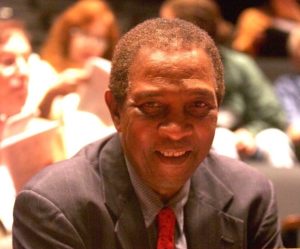
Carman Moore
1978 HIT! It was conductor Isaiah Jackson’s idea to bring NEXUS, the Rochester Philharmonic and composer Carman Moore together. Not only a composer, Moore is a music educator, and at this time had recently been the artistic director for the Harlem Opera Theater and Workshop and had helped launch the Society of Black Composers. He is also an author, having written The Story of Bessie Smith and when we met him, his history entitled “Black Sound in the USA” had just been published the year before. Moore’s percussion concerto Hit was written for and dedicated to NEXUS. Onstage, we were each placed in various strategic locations within the orchestra to facilitate our reactions and responses to each other and to the orchestra, creating a play of sonorities between the percussion and the rest of the orchestra. Moore wanted to expand symphonic music “to encompass our daily lives”, so not only were traditional percussion instruments used but also commonplace objects that had easily identifiable sounds: an anvil, boxing ring bell, pieces of steel, a police whistle, a siren. There were at least 16 assorted drums on the stage, and steel drums. Reviewers remarked that it was an audience pleaser: “Hit is as difficult to describe as one’s first kiss…overturning a seeming contradiction in terms, that is, a comfortable juxtaposition of Art and Noise.” The piece begins with a single “hit” or percussive strike, and moves through a glockenspiel-chime duet, some group bell improvisation, and a steel drum duet with a touch of calypso. The last section features a theme played by the orchestra followed by solos on drum sets, improv sections led by a cowbell and a finale with a drum and whistle march akin to Hail, Hail, The Gangs All Here. In a 2007 interview, Leigh Howard Stevens asked Bob Becker, “How are your drum set chops?” Bob replied, “Well, the older I get, the better they used to be. Truthfully, the last time I played set seriously was in 1978 when NEXUS premiered Carman Moore’s percussion concerto, Hit, with the Rochester Philharmonic. The last movement calls for three drum sets, and each one gets a big solo. Since then, I’ve played occasional sessions.” Read more: www.carmanmoore.com
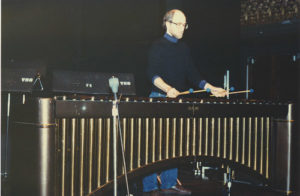
Russell playing the Truax marimba
1978 The TRUAX MARIMBA At Simon Fraser University in Vancouver BC, we programmed Nautilus by Canadian composer Barry Truax. Russell Hartenberger tells the Nautilus story: “In the mid-70s, Barry Truax contacted me about recording his percussion solo Nautilus, a work for large multi-percussion set-up and four computer-synthesized soundtracks. I recorded it at York University, released on Melbourne Records 1976. At the recording session, Barry told me that his father, Arnold Truax, had been a marimba player on CBC when he was younger, and that Arnold wanted to sell his marimba. Arnold lived a couple hours from Toronto so my wife Bonnie Sheckter and I drove to his house one day. We met Arnold and his wife, Olive, who had prepared a delicious meal for us with a memorable pumpkin pie topped with sour cream (not whipped cream). In addition to being a musician, Arnold was a man of many and varied interests. He had built a one-lane lap pool as part of an extension on his house and enclosed it in a kind of greenhouse-like structure. He was also a photographer and created his own dark room. At the time, Bonnie (an artist who now works in coloured pencil – see our recent Facebook posting) was a fine art printmaker using photo-lithography to create her prints. She wanted to make large-scale works but was limited by the commercially available trays for developing photographs. She told Arnold about this and he showed her how she could make her own trays any size and coat them with resin. When we returned home, Bonnie built trays based on Arnold’s design for use in creating her art.
“Barry taught at Simon Fraser University, so when NEXUS was booked there in 1978, we put his piece Nautilus on the program. Back to Arnold – his marimba was a 4.5 octave (C-F) Deagan No 70 Imperial instrument. The extra .5 octave was on the top end rather than the lower register. The bars on the low end of the marimba were larger than those on other marimbas and spaced a little further apart. The rosewood bars were all in remarkably good condition and it was obvious that Arnold had taken very good care of it. Arnold played a piece on the marimba for me – a popular piece from years ago, probably an example of his CBC repertoire from back in the day. I bought the marimba and brought it home with me.
“Barry decided to write a marimba solo for me to play on that instrument as a tribute to his father. That piece is Nightwatch for marimba and four soundtracks. Barry wanted to premiere and record Nightwatch in Vancouver, so I shipped the marimba there in a Nexus marimba road case, then flew out for the concert and recording. The premiere was at the Vancouver East Cultural Centre (must have been 1982) as part of the new music series there. I recorded the piece the next day and Barry released the piece on Cambridge Street Records. A few years ago I sold the marimba to a former student, Graham Hargrove, who is a percussionist with the Stratford Festival Orchestra. Graham is a very fine marimba player who is taking good care of the instrument.” A sound sample of Nightwatch on the special marimba is available at http://www.sfu.ca/sonic-studio-webdav/excerpts/Nightwatch.mp3
Read more: Barry Truax: www.thecanadianencyclopedia.ca; Nightwatch: https://www.sfu.ca/~truax/night.html
